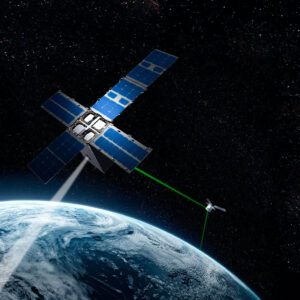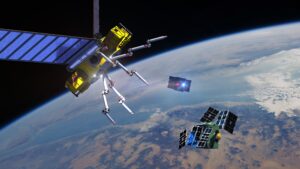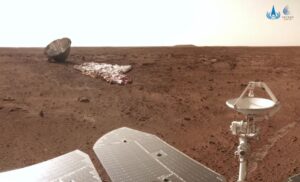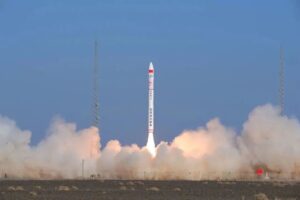Orion back at Kennedy Space Center so NASA can dissect Artemis I mission
Monday, 09 January 2023 20:03
The Orion space capsule from Artemis I has come full circle, having launched from Kennedy Space Center, traveled 1.4 million miles in space and around the moon, splashed back down to Earth in the Pacific Ocean, and now journeyed 2,500 miles over land for its return to Florida.
After Orion was recovered at sea on Dec. 11, it made its way to Naval Base San Diego before heading by truck to arrive at KSC on Dec. 30. It now sits at NASA's Multi Payload Processing Facility, still sealed tight from its celestial journey.
The passengers have been waiting patiently to get out of the capsule. Since they're just mannequins, though, they can wait a little longer.
The most human-looking of the three, named Commander Moonikin Campos in deference to the late Arturo Campos who helped NASA bring the Apollo 13 crew safely back to Earth, was joined by two partial-body mannequins named Zohar and Helga. Their presence will help NASA determine just what sort of radiation levels and other flight stresses humans will face during the first crewed flight of Orion on Artemis II.
Space Force looking to extend laser communications to satellites in higher orbits
Monday, 09 January 2023 19:10
The U.S. Space Force is requesting information on laser communications systems to connect satellites in medium and high orbits.
The post Space Force looking to extend laser communications to satellites in higher orbits appeared first on SpaceNews.
NOAA declares GOES-18 operational ahead of schedule
Monday, 09 January 2023 17:51
The National Oceanic and Atmospheric Administration declared the newest satellite in its geostationary fleet, GOES-18, operational Jan. 4 and designated it GOES West.
The post NOAA declares GOES-18 operational ahead of schedule appeared first on SpaceNews.
Are chemical rockets or solar sails better to return resources from asteroids?
Monday, 09 January 2023 17:47
If and when we ever get an asteroid mining industry off the ground, one of the most important decisions to be made in the structure of any asteroid mining mission would be how to get the resources back to where all of our other infrastructure is—somewhere around the Earth.
That decision typically will focus on one of two propulsion methodologies—chemical rockets, such as those we already use to get us into space in the first place, or solar sails, which, while slower and unable to get us into orbit, don't require any fuel. So which propulsion methodology is better for these future missions? A study by researchers at the University of Glasgow looked at those two scenarios and came out with a clear-cut answer—solar sails.
When answering these types of theoretical questions, it is essential to impose limits on the answers. For example, billions of asteroids exist in the solar system, so it's more realistic to only look at those known as near-Earth asteroids (NEAs).
Old NASA satellite falls harmlessly from sky off Alaska
Monday, 09 January 2023 14:33
Sentinel-1 and AI uncover glacier crevasses
Monday, 09 January 2023 13:32
Scientists have developed a new Artificial Intelligence, or AI, technique using radar images from Europe’s Copernicus Sentinel-1 satellite mission, to reveal how the Thwaites Glacier Ice Tongue in West Antarctica is being damaged by squeezing and stretching as it flows from the middle of the continent to the coast. Being able to track fractures and crevasses in the ice beneath the overlying snow is key to better predicting the fate of floating ice tongues under climate change.
Rogue Space hires sustainability expert to advocate for startup-friendly policies
Monday, 09 January 2023 12:34
Daniel Porras, a former executive at the Secure World Foundation, has joined Rogue Space, a startup developing small satellites for in-orbit services.
The post Rogue Space hires sustainability expert to advocate for startup-friendly policies appeared first on SpaceNews.
Historic UK rocket mission set for liftoff
Monday, 09 January 2023 12:22
Final preparations were under way Monday for the first rocket launch from UK soil, catapulting it into the "exclusive" club of nine nations able to send crafts into Earth's orbit.
A repurposed Boeing 747 carrying the 70-foot (21-meter) rocket containing nine satellites will take off from a spaceport in Cornwall, southwest England, at 2216 GMT.
The rocket will detach from the aircraft at a height of 35,000 feet over the Atlantic Ocean to the south of Ireland before later discharging the satellites.
The aircraft will then return to Spaceport Cornwall, a consortium that includes Virgin Orbit and the UK Space Agency, at Cornwall Airport Newquay.
The launch will be the first from UK soil. UK-produced satellites have previously had to be sent into orbit via foreign spaceports.
"Joining that really exclusive club of launch nations is so important because it gives us our own access to space... that we've never had before here in the UK," Spaceport Cornwall chief Melissa Thorpe told BBC television on Monday.
Over 2,000 people are expected to watch the launch named "Start Me Up" after the Rolling Stones song.
China’s Tianwen-1 Mars orbiter and rover appear to be in trouble
Monday, 09 January 2023 11:04
The two spacecraft making up China’s first interplanetary mission are both suffering issues, with the rover potentially lost on the surface after winter hibernation.
Rock Robotics Rock Base X offers 1600 channels across multiple constellations
Monday, 09 January 2023 11:03 ROCK Robotic announced the availability of ROCK Base, a state-of-the-art, triple-band multi-constellation RTK/GNSS base station. ROCK has also joined the Web3 GEODNET initiative, the world's largest decentralized GNSS reference network.
The combined solution will support critical applications in civil surveying, high-definition mapping and digital twin creation, as well as many next-genera
ROCK Robotic announced the availability of ROCK Base, a state-of-the-art, triple-band multi-constellation RTK/GNSS base station. ROCK has also joined the Web3 GEODNET initiative, the world's largest decentralized GNSS reference network.
The combined solution will support critical applications in civil surveying, high-definition mapping and digital twin creation, as well as many next-genera General Atomics awarded contract from Advanced Space for Cislunar Spacecraft for AFRL Oracle Program
Monday, 09 January 2023 11:03 General Atomics Electromagnetic Systems (GA-EMS) reports that it is under contract to Advanced Space LLC to build an ESPA-Grande class satellite, perform payload integration, and space vehicle test for the Air Force Research Laboratory (AFRL) Oracle spacecraft program. Oracle will demonstrate space situational awareness and Position, Navigation and Timing (PNT) techniques using advanced technolo
General Atomics Electromagnetic Systems (GA-EMS) reports that it is under contract to Advanced Space LLC to build an ESPA-Grande class satellite, perform payload integration, and space vehicle test for the Air Force Research Laboratory (AFRL) Oracle spacecraft program. Oracle will demonstrate space situational awareness and Position, Navigation and Timing (PNT) techniques using advanced technolo OneWeb to launch 40 satellites with SpaceX
Monday, 09 January 2023 11:03 OneWeb, the low Earth orbit (LEO) satellite communications company, will launch 40 satellites with SpaceX no earlier than Sunday, 8 January 2023, from Cape Canaveral Space Force Station in Florida. This launch will be OneWeb's sixteenth to date and its second with SpaceX following a successful launch in December, keeping the company on track to deliver global coverage in 2023.
This launch
OneWeb, the low Earth orbit (LEO) satellite communications company, will launch 40 satellites with SpaceX no earlier than Sunday, 8 January 2023, from Cape Canaveral Space Force Station in Florida. This launch will be OneWeb's sixteenth to date and its second with SpaceX following a successful launch in December, keeping the company on track to deliver global coverage in 2023.
This launch Pair of Chinese launches put classified and commercial satellites into orbit
Monday, 09 January 2023 08:37
China conducted its first two launches of 2023 over the weekend, sending three classified payloads into geosynchronous transfer orbit and five commercial satellites into sun-synchronous orbits.
ROCK Robotic announces ROCK Base, a 1,400-channel triple-frequency RTK base station
Monday, 09 January 2023 07:51 ROCK Robotic announced the availability of ROCK Base, a state-of-the-art, triple-band multi-constellation RTK/GNSS base station. ROCK has also joined the Web3 GEODNET initiative, the world's largest decentralized GNSS reference network.
The combined solution will support critical applications in civil surveying, high-definition mapping and digital twin creation, as well as many next-genera
ROCK Robotic announced the availability of ROCK Base, a state-of-the-art, triple-band multi-constellation RTK/GNSS base station. ROCK has also joined the Web3 GEODNET initiative, the world's largest decentralized GNSS reference network.
The combined solution will support critical applications in civil surveying, high-definition mapping and digital twin creation, as well as many next-genera Bullitt selects Skylo for its newly announced smartphones and two-way messaging service
Monday, 09 January 2023 07:51 Skylo, a Non-Terrestrial Network (NTN) operator, focused on connecting anything, anywhere, announced that it is partnering with Bullitt Group, the innovative British smartphone manufacturer, as Bullitt's satellite connectivity partner for its two-way satellite messaging smartphone.
Available in Q1 2023, and on show for the first time at CES 2023, the smartphone will feature Bullitt's new m
Skylo, a Non-Terrestrial Network (NTN) operator, focused on connecting anything, anywhere, announced that it is partnering with Bullitt Group, the innovative British smartphone manufacturer, as Bullitt's satellite connectivity partner for its two-way satellite messaging smartphone.
Available in Q1 2023, and on show for the first time at CES 2023, the smartphone will feature Bullitt's new m 
